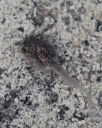Oak Toad (Anaxyrus quercicus)
Description: The oak toad can be identified by its light mid-dorsal stripe, variable brown and black spots, and proportionally large parotoid glands. One of the most remarkable features of this species is its small adult size relative to other toads. The male can be distinguished from the female by its clear white belly and a slightly distended, loose flap of skin beneath the mouth, which expands into the vocal sac. The female has a dark-spotted belly and lacks a vocal sac.
Habitat: The oak toad's natural habitat includes sandy pine flatwoods and oak scrub, open pine and pine-oak woods, pine or oak savanna with sandy soils, and maritime forests. They appear to favor open-canopied pine flatwoods with grassy ground cover.
Range: The toad's range extends across the coastal plains of the southeastern United States from eastern Louisiana to southeast Virginia and south throughout Florida.
Diet: The oak toad eats mainly small insects and other arthropods. The adult has a strong preference for ants. It is mostly diurnal and spends much of its time burrowed into the loose soil of its habitat
Reproduction: Breeding takes place in shallow pools that accumulate during heavy rains. The male expands his distinctive elongated vocal sac to produce a chirping call. The breeding season extends from April to October, peaking early on. Heavy, warm spring rains stimulate mating behavior.
An average of 300 to 500 eggs are laid in short strands of 3 to 8 eggs each, with each egg about a millimeter wide. The strands are attached to vegetation, usually submerged blades of grass 1.6 to 4.7 inches beneath the surface. Energy investment in producing this quantity of eggs is significant, and many females are found dead during the mating season due to the rigors of the process. Fertilization takes place externally, with sperm being released in the vicinity of the eggs. As with other species of toad, the male oak toad has a Bidder's organ, which can become a functional ovary in the event of testicular malfunction.
Status: In North Carolina & Virginia it is classified as Imperiled. Louisiana classified it as Vulnerable.
Subspecies: None
»» Kingdom: Animalia - Animals
»» Phylum: Chordata - Chordates
»» Subphylum: Vertebrata - Vertebrates
»» Class: Amphibia - Amphibians
»» Order: Anura - Frogs & Toads
»» Family: Bufonidae - Toads
»» Genus: Anaxyrus
»» Species: Anaxyrus quercicus - Oak Toad
This article uses material from the Wikipedia article "Oak Toad", which is released under the Creative Commons Attribution-Share-Alike License 3.0. Content may have been omitted from the original, but no content has been changed or extended.
|












